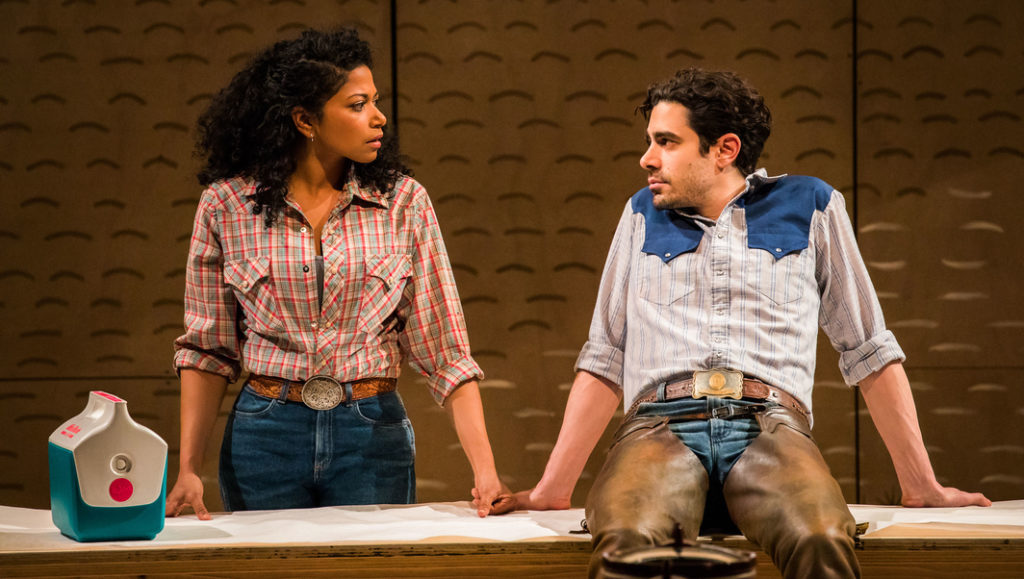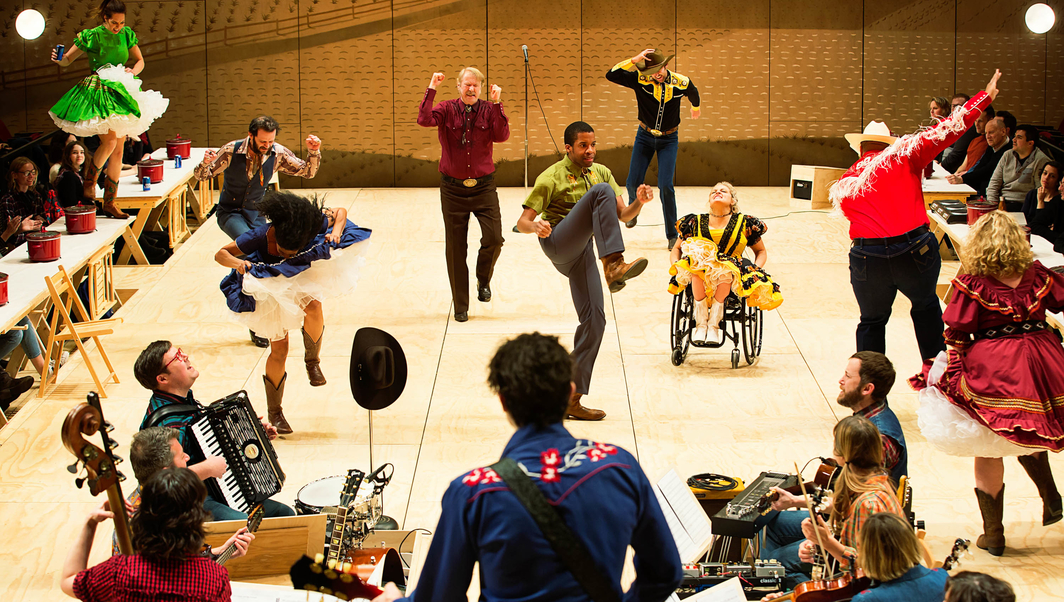Theater Review: Oklahoma!

Daniel Fish’s production of Oklahoma! is not what the traditional Broadway-goer would ever expect from a revival of Rodgers & Hammerstein’s classic American musical. It is electrifying.
This retelling is full of unexpected (and, yes, expected) delights. The orchestra (thanks to Daniel Kluger) has been striped down to a small ensemble of seven instrumentalists who sit on stage; rather than a sweeping orchestra, the music is comprised of sounds from instruments like a banjo, a fiddle, and drums. The text has not changed at all (despite what you may think since it feels so timely and modern) and this stripped-down music allows for the dialogue to really shine and be noticed.
Additionally, the instruments are not solely for the musicians; Damon Daunno, the actor who plays Curly, is frequently strumming an acoustic guitar as he saunters around the stage. And saunter he does. As Curly, Damon Daunno is charming and full of swagger. He croons mesmerizing songs to Laurey (Rebecca Naomi Jones) where the lighting turns the moment into to dreamlike-trances when she gets ensnared by him. In short, Curly knows exactly what (and who) he wants, and he gets it.
His foil is Jud (Patrick Vaill). They are opposites literally and figuratively. This Jud is not presented as some burly, would-be-rapist. He is not physically intimidating at all. Where Daunno has a head of curly dark hair and dark eyes, Vaill has straight, blonde hair and light eyes. Where Daunno exudes satisfaction and knowing his place in the world, Vaill is struggling to belong.
Unlike the more breezy productions before it, this Oklahoma! shows the loneliness of being on the outside in bold strokes. Vaill’s performance as Jud invokes an immense sense of sadness and pity. In “Poor Jud is Dead,” Curly’s cruelness is revealed as the high contrast black and white video zooms close on Jud’s face as Curly sings a song about Jud killing himself. Vaill’s mouth trembles; his eyes seem to water. He is the strange misfit–ok, perhaps with weird stalker leanings–who has fallen for someone who will never love him back (even if she might find him a little appealing). Jud’s not the only character whose vulnerability and essence is more noticeable in this production.
Let’s turn to Oklahoma!’s wide-range of female characters. Laurey (Rebecca Naomi Jones) is the young woman both the dashing cowboy and the lowly farmhand desire. Her Aunt Eller (Mary Testa) is a no-nonsense single woman who runs the farm. Gertie Cummings (Mallory Portnoy) is the rambunctious and desperate-for-attention girl. Finally, Ado Annie (Ali Stroker) is the spirited, sexually-free woman. In the show, women are objects the men fight over or buy. However, these woman reject that notion. Rebecca Naomi Jones plays Laurey with a stand-offish, steely resolve. She keeps her wall up until she decides what she wants. And, even as Ado Annie revels in male attention, she ultimately refuses to let dim-witted but lovable Will Parker (James Davis) boss her into an unequal marriage–if he gets to go out all night, so does she.
Ali Stroker, by the way, is fabulous. She’s joyful, energetic, and her comedic timing is on point. Her performance of “I Cain’t Say No” is a rousing song that will have you stomping and clapping with the beat. The fact that she moves from one end of the stage to the other, belting and dancing in her wheelchair makes her performance all the more impressive. Plus, her performances with James Davis and Will Brill (as Ali Hakim) are hilarious. [Other cast members of the fine ensemble include: Anthony Cason, Mitch Tebo, and Will Mann.]
While almost the entire fresh production feels spot-on, there was one moment that felt like a small misstep. The ballet interlude is now a modern dance, complete with smoke machine effects, spotlights, and a sequined “Dream Baby Dream” T-shirt worn by the dancer (Gabrielle Hamilton). The music is loud, electronic rock’n’roll and the blatantly sexual nature of the dance can’t be ignored. For all the fans of the traditional musical, this will be the one moment that audience members will most likely dislike.
One last unexpected detail that may surprise audiences who know the original production is the overt violence. The set (design by Laura Jellinek) itself is one giant community hall–where people gathered at in the past–and the audience feels like part of the action. Most of the time, the lights are on and because the theater is in the round you can watch your fellow audience members watching the show. You are a part of that community. However, the walls are lined with rifles. These rifles are a physical manifestation of the underlying violence permeating the territory/show. There’s a matching underlying sense of unease and danger that this production has uncovered in many key moments (between Curly and Jud and Jud and Laurey). While there may be sunny songs, there are also dark clouds lurking on the horizon. In facet, there’s, quite literally, a very bloody ending viewers won’t soon forget.
Oklahoma!‘s eery timeliness is proof of the universality of the show. Gender inequality, violence, and “the other” are all still issues we have today and something this beautiful musical (with some wonderful acting and production folks) forces us all to examine.
Oklahoma! is playing at the Circle in the Square Theatre. Click here for more information.
Photo Credit: Little Fang Photo



Discussion about this post